English
Nicholson - Coolun - Fl or Fl & Pf or Fl & Hp
 Coolun, A favorite Irish Air with Four Variations, by C. Nicholson
Coolun, A favorite Irish Air with Four Variations, by C. NicholsonGassett Collection - Facsimile Edition by C.A.Vater/Noteworthy Sheet Music
Piano Score and Flute Part, PDF $9.99
Charles Nicholson (1795-1837) was a masterful, hugely popular, and highly influential English flutist and teacher, famous for his individual style and powerful tone. Among Nicholson's compositions are 13 fantasies and 15 airs with variations, including Coolun. A favorite Irish Air with Four Variations arranged for the Flute with an ad libitum Accompaniment for the Piano Forte, or Harp. The "Coulin" or "Coolan" was described in an 1833 letter to the editor of the Dublin Penny Journal (www.libraryireland.com) as "an air, that once heard even in the earliest infancy, can never be forgotten—a melody which breathes the most touching tenderness and exquisite sensibility, and the memory of which, enables the Irish to hear Scotland's 'O, Nanny wilt thou gang with me,'—or her 'Banks and Braes,' without envious repinings."
Nicholson's consummate rendition of Coolun is highly effective when played either as a solo for flute alone or by flute with accompaniment of piano, lever harp, or pedal harp. The Gassett Collection print from which our facsimile was created consists of a score for piano forte and flute, without a separate flute part. The flute part included in our edition was created from the score using a modern music notation software program.
Noteworthy Sheet Music's publication of Coolun was favorably reviewed by Katherine Borst Jones in the January, 2014 issue of Flute Talk magazine. You can read the review, reproduced on our website for your convenience, or at Flute Talk (subscribers).
For additional information about the Gassett Collection, please see see our article An Introduction to the Gassett Collection.
Piano score, 6 pages; Flute part, 5 pages; Total, 15 pages.
Preview==============================================================================
To order our print edition of Coolun, A Favorite Irish Air arranged for Flute and Piano or Harp for $16.98 plus a $5.95 shipping and handling fee to addresses in the USA. Use the Contact Us form to let us know which hard copy publication(s) you would like to purchase, along with your email contact information and USPS mailing address. We will then send you a PayPal invoice for the sale and, once we receive notice from PayPal that you have paid for the item(s), we will ship your music to the address provided.
Nicholson - A School for the Flute
 A School for the Flute, by C. Nicholson
A School for the Flute, by C. NicholsonGassett Collection - Facsimile Edition by Peter H. Bloom
Volume I, PDF $10.50
Volume II, PDF $10.50
Charles Nicholson (1795-1837) was the most renowned flutist in the English-speaking world during the first half of the 19th century. His artistry, style, and technical innovation remain forceful influences more than a century and a half after his death. Before the meteoric rise of the Boehm flute put an end to glorious diversity in the flute world, there were three categories of flutes from which to choose: small hole French style flutes; large hole Nicholson style flutes; and flutes with moderate holes. Nicholson's A School for the Flute, published in 1836, addresses all three styles of instruments and provides clear direction to players of each. He also provides us with a wealth of information on style and performance practice in the 19th century. (excerpted from the foreword by P. H. Bloom)
Please note that this is an un-enhanced facsimile, a scan of an historical edition, so there are areas that are faded, uneven, or otherwise imperfect based on the condition of the original document.
Volume I: 75 pages including a foreword by Peter H. Bloom, $10.50
Nicholson addresses fundamentals of music and goes on to present a thorough treatise on flute-playing technique including detailed analyses of fingerings and articulations accompanied by clear and useful musical examples.
Volume II: 68 pages including a foreword by Peter H. Bloom, $10.50
Nicholson provides lessons and observations concerning his approach to style, taste and performance practice as well as technique.
Hewitt - Trip to Nahant - Flute + Clarinet
 Trip to Nahant, by James Hewitt
Trip to Nahant, by James HewittArranged as a Duet for Flute and Clarinet by John W. Pratt
Flute Part, Bb Clarinet Part, alternate A Clarinet Part, and Score ― PDF $5.99
James Hewitt (1770-1827) moved from London to New York in 1792 and was active in both New York and Boston as a composer, arranger, music publisher, performer, teacher, and orchestra conductor. In Hewitt's time, Nahant was an island connected to the mainland by a sandbar submerged at high tide, now a causeway. It was a popular, cool place for day trips from Boston and later became a fashionable summer resort.
Hewitt's Trip to Nahant, a favorite Rondo (1811) was written for keyboard, and is typical of American music of the period. It is charming, light in texture and subject, and well suited to arrangement for flute and clarinet. (adapted from JWP's foreword to the edition) We provide parts for Flute and Clarinet in Bb, along with an alternative part for Clarinet in A and a Score in concert pitch.
Flute part, 2 pages; Bb Clarinet part, 2 pages; alternate A Clarinet part, 2 pages; Score, 4 pages; Total, 16 pages.
PreviewHatton - Wreck of the Hesperus - Theatre Orchestra
 The Wreck of the Hesperus, by J. L. Hatton & H. W. Longfellow
The Wreck of the Hesperus, by J. L. Hatton & H. W. LongfellowArranged for theatre or salon orchestra by Peter H. Bloom
Tenor, Flute, Clarinet, Violin, Viola, & Double Bass Parts, and Mini-Score ― PDF $19.98
The "dramatic scena" was an especially popular entertainment at its zenith in the mid-nineteenth century throughout the English speaking world. John Liptrot Hatton's setting of Longfellow's Wreck of the Hesperus is the very model of the dramatic scena at its finest, and a magnificent showcase for an heroic tenor. Longfellow's ballad recounts a chilling tale loosely based on conflated reports of two New England shipwrecks that occurred during a single devastating blizzard in 1839. This arrangement of Wreck of the Hesperus for theatre or salon orchestra was made for the now retired D.C. Hall's New Concert and Quadrille Band of Boston, and their extraordinary tenor Kevin McDermott. It can be heard on the Hall's Band's CD recording "Grand Concert," winner of the Noah Greenberg Award of the American Musicological Society. (excerpted from Peter H. Bloom's © foreword)
Click the mp3 icon to listen to an audio clip of Wreck of the Hesperus from the Hall's Band CD recording Grand Concert!.

The D.C. Hall's Grand Concert! CD is available from NSM - click to access the page.
Tenor part, 4 pages; Flute part, 2 pages; Bb Clarinet part, 2 pages; Violin part, 2 pages; Viola part, 2 pages; Double bass part, 2 pages; Mini-Score, 8 pages; Total, 26 pages.
Preview===========================================
We also offer a professionally-printed hard copy edition of The Wreck of the Hesperus for $29.97 plus a $5.95 shipping and handling fee to addresses in the USA. Please use the Contact Us form to let us know which hard copy publication(s) you would like to purchase, along with your email contact information and USPS mailing address. We will then send you a PayPal invoice for the sale and, once we receive notice from PayPal that you have paid for the item(s), we will ship your music to the address provided.
Bridge – 4 Short Pieces – Flute or Alto Flute (and Piano)
 4 Short Pieces, by Frank Bridge
4 Short Pieces, by Frank BridgeTranscribed for Flute or Alto Flute (and Piano) by J.W.Pratt
Flute Part, Alto Part, PDF $8.99
The 4 Short Pieces by Frank Bridge were written for violin and piano, and first published in 1912. As noted in John Pratt's foreword to the edition, they "provide a fine and delightful introduction to an accessible post-romantic composer who should be better known." The pieces are "Meditation", "Spring Song", "Lullaby", and "Country Dance". Mr. Pratt has created transcriptions of the violin parts for both flute and alto flute, and we include both instrument versions in this edition. We think Nos. 1 and 3 sound particularly nice on the alto flute and No. 4 is a splendid romp on the C flute, but all four are effective on either instrument, so we prefer to let our flutists decide on which instrument they choose to play each piece. We provide only our flute and alto flute transcriptions; the piano score, including the original violin part, is available as a free pdf download at imslp.org.Flute part, 5 pages; Alto Flute part, 5 pages; Total, 14 pages.
PreviewElgar – Salut d’Amour – Alto Flute & Piano
 Salut d’Amour, Op. 12, by Edward Elgar
Salut d’Amour, Op. 12, by Edward ElgarTranscribed for Alto Flute and Piano by C. A. Vater
Piano Score and Part for Alto Flute, PDF $6.99
The English composer Edward Elgar held many positions throughout his career, including those of organist at St. George’s Roman Catholic Church in Worcester, conductor of the Worcester Philharmonic, Professor of Music at the University of Birmingham, and conductor of the London Symphony Orchestra. He achieved considerable prominence as a result of his many successful orchestral, vocal, and chamber music compositions. Elgar composed this piece in 1888, as an engagement gift to his beloved future wife. Though first written for piano solo, arrangements were created shortly thereafter by the composer himself for violin and piano, and for orchestra. Originally titled “Liebesgruss” (Love’s Greeting), but later changed to Salut d’Amour, the piece is now one of Elgar’s most widely recognized works, and its immense popularity has led to arrangements for a wide variety of other instruments. We provide here a transcription of Salut d’Amour for alto flute and piano, which has been adapted from the editions published by Schott for violin and piano, oboe and piano, or orchestra and which are now in the public domain.
Score, 4 pages; Alto Flute part, 2 pages; Total, 10 pages.
Preview
Bridge – 4 More Short Pieces – Flute or Alto Flute (and Piano)
 Cradle Song, Gondoliera, Mélodie, and Elégie, by Frank Bridge
Cradle Song, Gondoliera, Mélodie, and Elégie, by Frank BridgeTranscribed for Flute or Alto Flute (and Piano) by J. W. Pratt
Preview
Flute Part, Alto Part, PDF $11.99
Like the 4 Short Pieces for Violin and Pianoforte published in transcription by Noteworthy Sheet Music earlier this year, these additional four short pieces by Bridge "provide a fine and delightful introduction to an accessible post-romantic composer who should be better known." Published by Bridge between 1903 and 1911, the works included in our second edition are transcriptions of Cradle Song, written for violin or cello and piano, Gondoliera for violin and piano, and Mélodie and Elégie for cello and piano. Mr. Pratt has created transcriptions of all four pieces for both flute and alto flute, and we include both instrument versions in this combined edition. We think Cradle Song and Elégie are particularly beautiful on the alto flute, but all are effective on either instrument, so we prefer to let our flutists decide on which instrument they choose to play each piece. We provide our flute and alto flute parts only; the original piano scores work well with our transcriptions and are available, along with the violin and cello parts, as free pdf downloads at imslp.org—click the links to access the scores for Cradle Song, Gondoliera, Mélodie, and Elégie.
Flute part, 6 pages; Alto Flute part, 6 pages; Total, 14 pages.Elgar – Mot d’Amour – Alto Flute & Piano
 Mot d’Amour, Op.13, No.1, by Edward Elgar
Mot d’Amour, Op.13, No.1, by Edward ElgarTranscribed for Alto Flute and Piano by C. A. Vater
Piano Score and Part for Alto Flute, PDF $5.49
In 1888, Elgar composed Salut d’Amour, now one of his most-recognized pieces, as an engagement gift for his beloved fiancée. Later he wrote Mot d'Amour (Love's Word) for violin and piano as a companion piece to Salut d’Amour. Mot d'Amour, which was initially given the German title Liebesahnung, was published in 1889 by Osborn & Tuckwood in the edition 2 Pieces for Violin & Piano that included this piece and a second one, less well-suited to alto flute, called Bizarrerie. Mot d’Amour is similar to Salut d’Amour in being light, charming, and highly romantic. Although Mot d’Amour never attained the level of popularity achieved by the earlier work, it is considered by some to be the finer composition (https://www.elgar.org/3salut.htm). Both Salut d’Amourand Mot d'Amoursound especially rich and mellow when performed on alto flute, and both pieces are now available from Noteworthy Sheet Music as transcriptions for alto flute and piano, adapted from the composer’s violin and piano editions now in the public domain and available on imslp.org.
Score, 4 pages; Alto Flute part, 1 page; Total, 8 pages.
Elgar - Chanson de Matin - Fl & Pf
 Chanson de Matin, Op.15, No.2, by Edward Elgar
Chanson de Matin, Op.15, No.2, by Edward ElgarTranscribed for Flute and Piano by C.A.Vater
Flute Part and Piano Score, PDF $6.99
Edward Elgar composed his Chanson de Matin for violin and piano c.1889-1890. The two companion pieces, Chanson de Matin (No. 2) and Chanson de Nuit (No. 1), together constitute his Op.15, and both pieces were later arranged for small orchestra by the composer. Chanson de Matin was received with great enthusiasm, and its initial and lasting popularity can be attributed largely to its strong melodic appeal. Enduring public affection for the piece has spawned the creation of numerous arrangements and transcriptions, including renditions for cello and piano, viola and piano, flute and guitar, piano solo, organ solo, and string quartet. Noteworthy Sheet Music offers two of our own transcriptions of the lovely Chanson de Matin, one for alto flute and piano and one for concert flute and piano.
Flute part, 2 pages; Piano Score, 4 pages; Total, 12 pages.
PreviewElgar - Chanson de Matin - AFl & Pf
 Chanson de Matin, Op.15, No.2, by Edward Elgar
Chanson de Matin, Op.15, No.2, by Edward ElgarTranscribed for Alto flute and Piano by C.A.Vater
Alto Flute Part and Piano Score, PDF $6.99
Edward Elgar composed his Chanson de Matin for violin and piano c.1889-1890. The two companion pieces, Chanson de Matin (No. 2) and Chanson de Nuit (No. 1), together constitute his Op.15, and both pieces were later arranged for small orchestra by the composer. Chanson de Matin was received with great enthusiasm, and its initial and lasting popularity can be attributed largely to its strong melodic appeal. Enduring public affection for the piece has spawned the creation of numerous arrangements and transcriptions, including renditions for cello and piano, viola and piano, flute and guitar, piano solo, organ solo, and string quartet. Noteworthy Sheet Music offers two of our own transcriptions of the lovely Chanson de Matin, one for alto flute and piano and one for C-flute and piano.
Alto Flute part, 2 pages; Piano Score, 4 pages; Total, 12 pages.
PreviewBridge – Two Pieces: Pensiero and Allegro appassionato – trans. for Clarinet and Piano
 Two Pieces: Pensiero and Allegro appassionato, by Frank Bridge
Two Pieces: Pensiero and Allegro appassionato, by Frank BridgeTranscribed for B-flat Clarinet and Piano by C.A.Vater
Score and Part; PDF $10.99
Certain chamber works written for viola can also work very beautifully when transcribed for clarinet, and indeed may actually be coveted by clarinetists. Brahms’ Two Songs for Voice, Viola and Piano, Op. 91 is one such piece, and our transcription has become one of NSM’s most popular publications. Clarinetists may discover that our adaptation of the viola part of Frank Bridge’s Two Pieces: Pensiero and Allegro appassionato, written for viola and piano, is also well-conceived and enjoyable to play. As suggested by their titles, these two pieces were written in very different styles, but they complement each other well, showing off Bridge’s composing versatility and providing performers an opportunity to display a range of emotions and capabilities. In our edition, we have raised the Pensiero key from F minor to G minor, taken a few passages in both pieces 8va to bring them into clarinet range, and created clarinet-friendly adaptations for the viola’s occasional double stops, but otherwise the pieces remain as Bridge composed them.
Score, 10 pages; Clarinet part, 3 pages; Total, 16 pages.
Preview
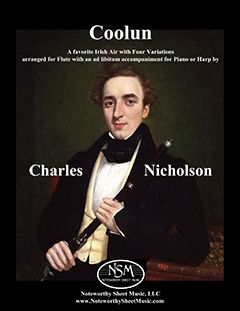 Coolun, A favorite Irish Air with Four Variations, by C. Nicholson
Coolun, A favorite Irish Air with Four Variations, by C. Nicholson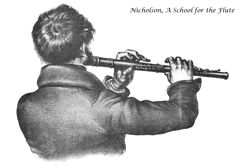 A School for the Flute, by C. Nicholson
A School for the Flute, by C. Nicholson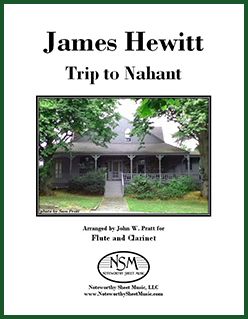 Trip to Nahant, by James Hewitt
Trip to Nahant, by James Hewitt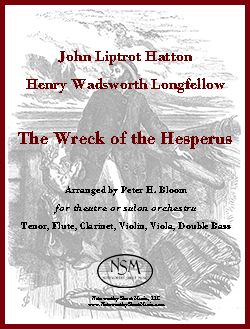 The Wreck of the Hesperus, by J. L. Hatton & H. W. Longfellow
The Wreck of the Hesperus, by J. L. Hatton & H. W. Longfellow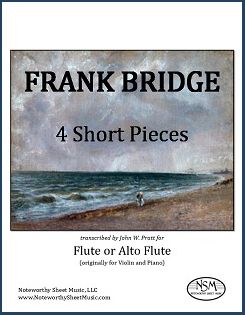 4 Short Pieces, by Frank Bridge
4 Short Pieces, by Frank Bridge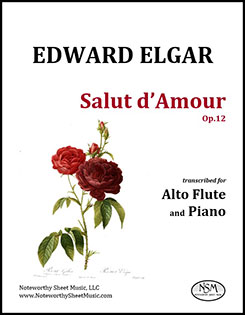
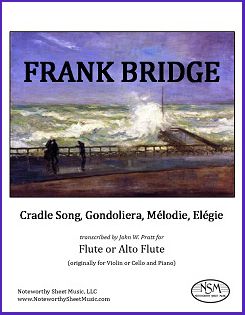 Cradle Song, Gondoliera, Mélodie, and Elégie, by Frank Bridge
Cradle Song, Gondoliera, Mélodie, and Elégie, by Frank Bridge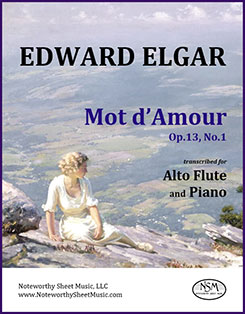 Mot d’Amour, Op.13, No.1, by Edward Elgar
Mot d’Amour, Op.13, No.1, by Edward Elgar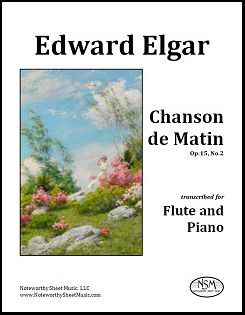 Chanson de Matin, Op.15, No.2, by Edward Elgar
Chanson de Matin, Op.15, No.2, by Edward Elgar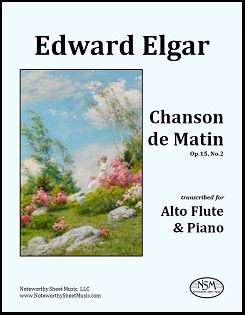 Chanson de Matin, Op.15, No.2, by Edward Elgar
Chanson de Matin, Op.15, No.2, by Edward Elgar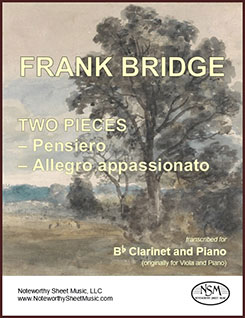 Two Pieces: Pensiero and Allegro appassionato, by Frank Bridge
Two Pieces: Pensiero and Allegro appassionato, by Frank Bridge